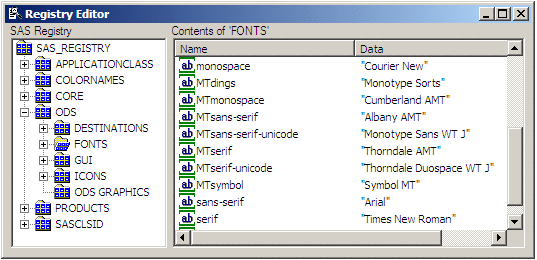Changing Fonts in a Style Template
Notice that all of the recommended
styles use Sans-serif fonts. The following example shows how to create
a custom style that uses Serif fonts instead. The example uses the
STATISTICAL style as a starting point (parent) for the custom style.
The following PROC
TEMPLATE code shows the beginning of the style definition for the
STATISTICAL style, which is delivered with the SAS System. Only the
code to be modified is shown.
proc template;
define style Styles.Statistical;
parent = styles.default;
style fonts /
'TitleFont2'=("<sans-serif>, <MTsans-serif>, Helvetica,Helv",2,bold)
'TitleFont'=("<sans-serif>, <MTsans-serif>, Helvetica,Helv",3,bold)
'StrongFont'=("<sans-serif>, <MTsans-serif>, Helvetica,Helv",2,bold)
'EmphasisFont'=("<sans-serif>, <MTsans-serif>, Helvetica,Helv",2,italic)
'FixedFont'=("<monospace>, Courier",2)
'BatchFixedFont'=("SAS Monospace, <monospace>, Courier, monospace",2)
'FixedHeadingFont'=("<monospace>, Courier, monospace",2)
'FixedStrongFont'=("<monospace>, Courier, monospace",2,bold)
'FixedEmphasisFont'=("<monospace>, Courier, monospace",2,italic)
'headingEmphasisFont'=("<sans-serif>, <MTsans-serif>, Helvetica,
Helv",2,bold italic)
'headingFont'=("<sans-serif>, <MTsans-serif>, Helvetica, Helv",2,bold)
'docFont'=("<sans-serif>, <MTsans-serif>, Helvetica, Helv",2);
style GraphFonts /
'GraphDataFont'=("<sans-serif>, <MTsans-serif>",7pt)
'GraphUnicodeFont'=("<MTsans-serif-unicode>",9pt)
'GraphValueFont'=("<sans-serif>, <MTsans-serif>",9pt)
'GraphLabelFont'=("<sans-serif>, <MTsans-serif>",10pt)
'GraphFootnoteFont'=("<sans-serif>, <MTsans-serif>",10pt,italic)
'GraphTitleFont'=("<sans-serif>, <MTsans-serif>",11pt,bold)
'GraphAnnoFont'=("<sans-serif>, <MTsans-serif>",10pt);
/* more code */
end;
run;
We make the following
changes:
-
Assign a name to a new style that identifies STATISTICAL as its parent style. It is recommended that you create a new style of a different name so that access to the existing style is not blocked. See discussion under Controlling ODS Search Paths.
Two style elements govern
all fonts in a style: the Fonts element governs tables, and the GraphFonts
element governs graphs. When changing fonts in a style, be sure to
make consistent changes to both elements. In this case, we want to
change from a sans-serif font to a serif font. You can also change
font size, weight, and style.
In style templates,
the name of a font family normally appears as a quoted string. However,
ODS also supports an indirect reference to a font family. When a font
name appears between less than and greater than symbols, such as <sans-serif>, it means that the font family sans-serif is defined in the SAS Registry. For
the Windows Release of SAS, here are some of the registry keys and
values that are stored under ODS Fonts:
Fonts:
The registry definition
of MTsans-serif and MTserif refer to TrueType fonts that are shipped
with SAS and are similar to "Arial" and "Times New Roman." These "MT"
fonts (short for Monotype) can be used on any computer where SAS is
installed. A specific font family such as "Verdana" could be used
instead. Note that fonts are normally listed in a "most-specific"
to "most generic" order so that reasonable substitution can be made
when a font cannot be located on the current computer.
Notice that several
graph fonts affect different parts of a graph. The following table
shows some but not all features that are affected by the graph fonts:
|
Used for adding special
glyphs (for example, α , ±, € ) to text in the graph
(see Adding and Changing Text in a Graph).
|
|
The SAS Output Delivery System: User's Guide provides information and examples of all predefined
style elements and attributes.
In our example, we will
name our modified style template SerifStatistical , change all occurrences of sans-serif to serif, change all occurrences
of MTsans-serif to MTserif, and change Helvetica and Helv (sans-serif
fonts) to Times (a serif font):
proc template; define style Styles.SerifStatistical ; parent = styles.statistical; style fonts / 'TitleFont2'=(" <serif> , <MTserif> , Times ",2,bold) 'TitleFont'=(" <serif> , <MTserif> , Times ",3,bold) 'StrongFont'=(" <serif> , <MTserif> , Times ",2,bold) 'EmphasisFont'=(" <serif> , <MTserif> , Times ",2,italic) 'FixedFont'=("<monospace>, Courier",2) 'BatchFixedFont'=("SAS Monospace, <monospace>, Courier, monospace",2) 'FixedHeadingFont'=("<monospace>, Courier, monospace",2) 'FixedStrongFont'=("<monospace>, Courier, monospace",2,bold) 'FixedEmphasisFont'=("<monospace>, Courier, monospace",2,italic) 'headingEmphasisFont'=(" <serif> , <MTserif> , Times ", 2,bold italic) 'headingFont'=(" <serif> , <MTserif> , Times ",2,bold) 'docFont'=(" <serif> , <MTserif> , Times ",2); style GraphFonts / 'GraphTitleFont'=(" <serif> , <MTserif> ",11pt,bold) 'GraphFootnoteFont'=(" <serif> , <MTserif> ",10pt,italic) 'GraphLabelFont'=(" <serif> , <MTserif> ",10pt) 'GraphValueFont'=(" <serif> , <MTserif> ",9pt) 'GraphDataFont'=(" <serif> , <MTserif> ",7pt) 'GraphUnicodeFont'=(" <MTserif-unicode> ",9pt) 'GraphAnnoFont'=(" <serif> , <MTserif> ",10pt); end; run;
